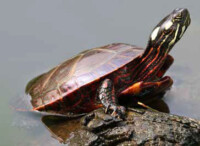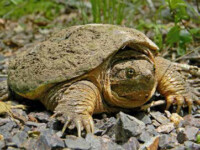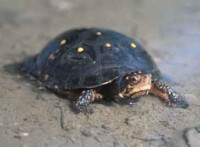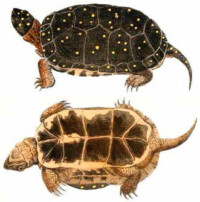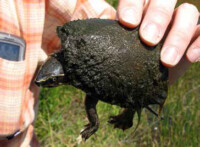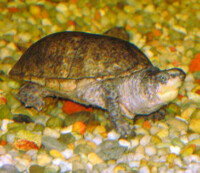- Close view of painted turtle (Chrysemys picta). Photo by Greg Schechter.
- Row of painted turtles sunning. Photo by Justine Kibbe.
- Snapping turtle (Chelydra s. serpentina) crossing road near Dwyer House. Photo by Justine Kibbe.
- Snapping turtle in repose. Photo by Dakota L.
- Spotted turtle (Clemmys guttata). Photo by John J. Mosesso, NB II.
- Spotted Turtle illustrations from “North American Herpetology,” Holbrook, 1842.
- Musk (or stinkpot) turtle (Sernotherus odoratus). Photo by Sandy Richard.
- Musk (or stinkpot) turtle in aquarium. Photo by Trisha Shears.
Fresh Water Turtles of Fishers Island
by Penni Sharp
Painted Turtle (Chrysemys picta)
On any sunny spring or summer day, anyone passing by one of Fishers Island’s freshwater ponds may catch a glimpse of turtles basking on an exposed rock or fallen tree. These turtles are most likely to be painted turtles (Chrysemys picta), probably the most common and conspicuous turtle on the island. They are often seen at the Madeline Avenue Pond and the Duck Pond. These turtles are also known as “sun turtles” for the time they spend resting in the sun. They can be seen basking from early spring into the fall. The painted turtle is a turtle of small to medium size and has a smooth carapace bordered with yellow and red markings. It can also be identified by its yellow neck stripes and the red and yellow stripes on its legs. The plastron (or belly portion of the shell) is yellow-orange.
Painted turtles thrive in muddy-bottomed still waters, avoiding fast-flowing streams and brackish water. They can tolerate a nitrogen-rich environment which results in dense blooms of algae and pond weeds, a source of food for the painted turtle. Painted turtles are omnivorous and in addition to algae and pondweeds, their diet includes fish, tadpoles, and a wide variety of invertebrates. Although aquatic, painted turtles are frequently found on land. Males tend to roam more often and widely than females which move primarily during the nesting season. Painted turtles may live to thirty years or more if not preyed upon by raccoons, foxes, or skunks. Their eggs, which can be deposited in gravelly soils, lawns, or fields, are also vulnerable to prey species.
Snapping Turtle (Chelydras. serpentina)
Another common island turtle is the snapping turtle (Chelydras. serpentina), the largest freshwater turtle in the northeastern United States. There are many records of large snapping turtles being seen on Fishers Island, including a 40 pounder removed from a back porch by Ed Horning and his son. These turtles are easily recognized by their carapace which is bordered along the rear by saw-toothed plates. The fairly long plated tail is also distinctive. They have large heads, long necks and a sharp hooked beak. Snapping turtles tend to be aggressive, thus should be handled with care or not at all.
Snapping turtles are found in a variety of aquatic habitats, preferring permanent bodies of fresh water. They will also be found in brackish and occasionally salt water. On Fishers, they are common at Middle Farms, Barley Field, Mud Pond, and Treasure Pond. They are tolerant of pollution and disturbance and are known to concentrate toxins in their bodies without noticeable ill effects.
Another omnivore, snapping turtles consume aquatic plants, fish, crayfish, and occasionally ducklings. Plants and non-game fish are the preferred diet. Their eggs and young are prey species for a wide range of predators. Adult snapping turtles have few natural enemies and are killed primarily by humans out of fear or due to the presumed attacks on waterfowl and game fish.
Spotted Turtle (Clemmys guttata)
Other fresh water turtles reported to inhabit Fishers Island include the spotted turtle (Clemmys guttata) and the stinkpot or musk turtle (Sernotherus odoratus). The records for the spotted turtle are scant and the last sighting was in the mid-1980s. The spotted turtle looks much like the painted turtle in that it is of small to medium size and has a smooth carapace. It is distinguished by the many yellow spots sprinkled on its black carapace. It also has a large orange blotch behind each eye. This turtle, sometimes referred to as the “polka dot” turtle, is a Species of Special Concern in New York State. It is probable that they are no longer extant on Fishers Island. Any sightings should be reported to the Museum.
Musk Turtle (Sernotherus odoratus)
The stinkpot may persist on the island as one was caught and released from Middle Farms Pond in 1990. However they are secretive and nocturnal and thus would be seldom seen. This turtle has four musk-producing glands on the underside of the carapace edges and it emits a foul odor when disturbed. The turtle has a high-domed carapace and it resembles an algae covered small rock. The plastron is small, leaving the turtle’s underside largely unprotected. The musk turtle has a large head for its body size and there are barbels (spiny appendages) on the chin and throat. Their preferred habitat includes slow-moving, muddy-bottomed rivers and streams and shallow, weedy coves of lakes and ponds. The turtle is primarily carnivorous and feeds on snails, leeches, worms, small fish and tadpoles. Museum records indicate that this turtle has only been documented at Middle Farms Pond, first by H. Lee Ferguson, Jr. in the 1920s and later by Ed Horning. Again, the Museum would be interested in any future sightings of this elusive turtle species.

